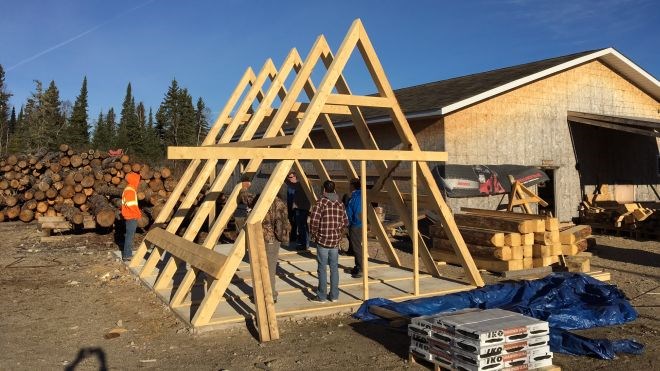A northwestern Ontario First Nation is exploring avenues on how to expand its thriving sawmill operation and delve into more value-added manufacturing.
A small four-employee multi-dimensional lumber mill on the large reserve, north and west of Sioux Lookout, has been busy serving needs of the community, nearby Sioux Lookout, and many area tourism outfitter camps.
“The rough sawn lumber is going out the door fast,” said Bert Hennessey, general manager of Obishikokaang Resources Corporation (ORC). “It’s just the (operating) margins aren’t the best.”
The corporation is shepherding along a plan to expand into a two-sawmill operation offering a wider array of forest products.
“People are excited about the facility,” said Hennessey, based on the volume of walk-in visitors asking for slabs and ordering products.
“It’s small but to be really successful in the future it’s going to need funding to be more mechanized and efficient with new equipment.”
ORC, which manages the Lac Seul Forest, oversees forest access road maintenance and silviculture programs while protecting culturally sensitive areas and animal habitat.
The fibre that comes out of the Lac Seul Forest, which lies within the community’s traditional territory, has been fashioned into decorative picnic tables, sheds, floating docks, saunas, cabins and very popular A-frame micro-homes.
The homes are being sold on the reserve and Sioux Lookout but the eventual plan is build them in components to be able to ship by flatbed trailer to a broader market.
Over the summer, they implemented a marketing strategy with a launch of a sawmill website (lacseulsawmill.ca) allowing customers to see their catalogue of products.
Hennessey said while the sawmill is busy with orders, it’s just a matter of fine-tuning the operation over time to install more mechanization to complete orders faster, achieve better efficiencies, and improve margins.
“All that work has been done. It’s a matter of packaging it into a business plan and applying for some capital funds to build another building to house another sawmill in an area where they can do some value-added construction.”
Over the next few months, Hennessey expects to make announcements on project capital funding as they roll out their business plan and concept.
Site engineering is taking place to dig into the nuts and bolts of constructing another mill over the next 12 months.
Recently, the Lac Seul Forest was certified under Sustainable Forest Initiative (SFI) standards, which meets the world’s highest standards in management practices.
Hennessey estimates logging contractors harvest between 500,000 and 600,000 cubic metres of hardwood and conifer which is sold to Weyerhaeuser’s Kenora laminated strand lumber mill, Kenora Forest Products, Domtar – their biggest customer – the Resolute Forest Products mill in Atikokan, and the EACOM plant in Ear Falls.
An allocation of 50,000 cubic metres is set aside for community use but wood supply is not an issue.
They have a backlog of fibre from when the forest was down for years after the bankruptcy of Buchanan Lumber, which shuttered its McKenzie sawmill in nearby Hudson.
Since the mill project was launched last fall, Hennessey said they’ve received an amazing amount of support and advice from Resolute, FP Innovations – the federal forest products research agency – and some sawmill and pulp mill veterans in the northwest.
Montreal-based Resolute first connected them with FP Innovations, which invited them to their Quebec City headquarters for a tour of value-added plants in the area.
The agency set aside funding to assign industry advisor Perry Champagne to the project. He is assisting them with the start-up aspects of a value-added mill. It’s quite encouraging to Hennessey.
“They don’t dedicate their funding to something they don’t feel is going to be successful.”
Initially, Hennessey said they planned to build a whole new facility, but FP and Resolute advised them to build off the mill they already have.
“Any development that’s going to happen will happen at the existing site.”
The past few months have been spent applying to government funders; completing safety, marketing and mill efficiencies studies; and compiling a list of needs toward expansion.
Their value-added mill plan also called for the reinstatement of a ferry service on Lac Seul to haul fibre to the mill and transport passengers in from outlying communities.
The thinking behind marine transport is to cut haul distances by truck, improve savings, and reduce carbon emissions.
Hennessey said planning for that will be somewhere down the line during a second phase after the value-added mill is operating.
A real concern in the Lac Seul Forest is the province’s proposed Species at Risk rules under the Endangered Species Act
If it were finalized today, “it would probably collapse some companies because there’s not enough wood to pay for the forest management,” said Hennessey, a former regional manager of tenure with the Ministry of Natural Resources and Forestry (MNRF)
“(The province) would have to combine two forest management units together to cover a large area.
“The cost of forest management (planning) is not cheap in Ontario with all the regulatory framework.”
He feels the existing Crown Forest Sustainability Act is “more than adequate” in safeguarding animal and plant habitat.
“First Nations are very committed to sustainability in forest management. They’re not standing on one pillar in protecting the environment, they’re looking at the cultural and economic (aspects) too.
“There’s millions spent by the province to develop First Nation companies and ESFLs (Enhanced Sustainable Forest Licence) and to have another policy coming out that potentially collapses those companies doesn’t make any sense.”
Hennessey said it’s been frustrating that their calls for consultation having gone unheeded by Premier Kathleen Wynne and Natural Resources Ministry Kathryn McGarry.
He hinted many forestry stakeholders in the northwest may resort to legal means to force the province and the MNRF to meet the minimum consultation requirements in allowing Northerners and First Nations to provide technical input on the new policy rules.




